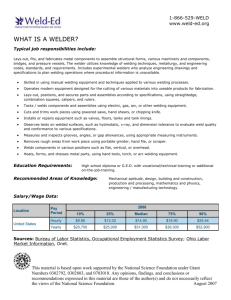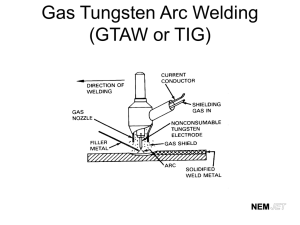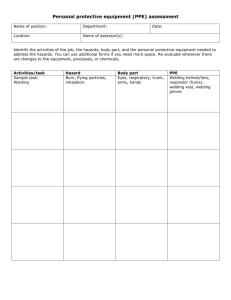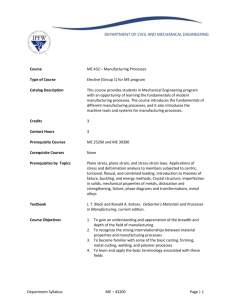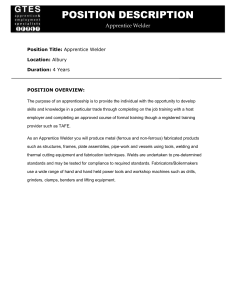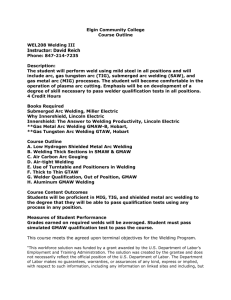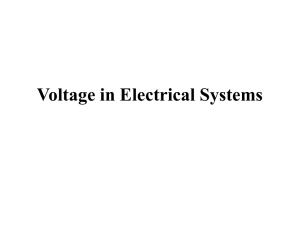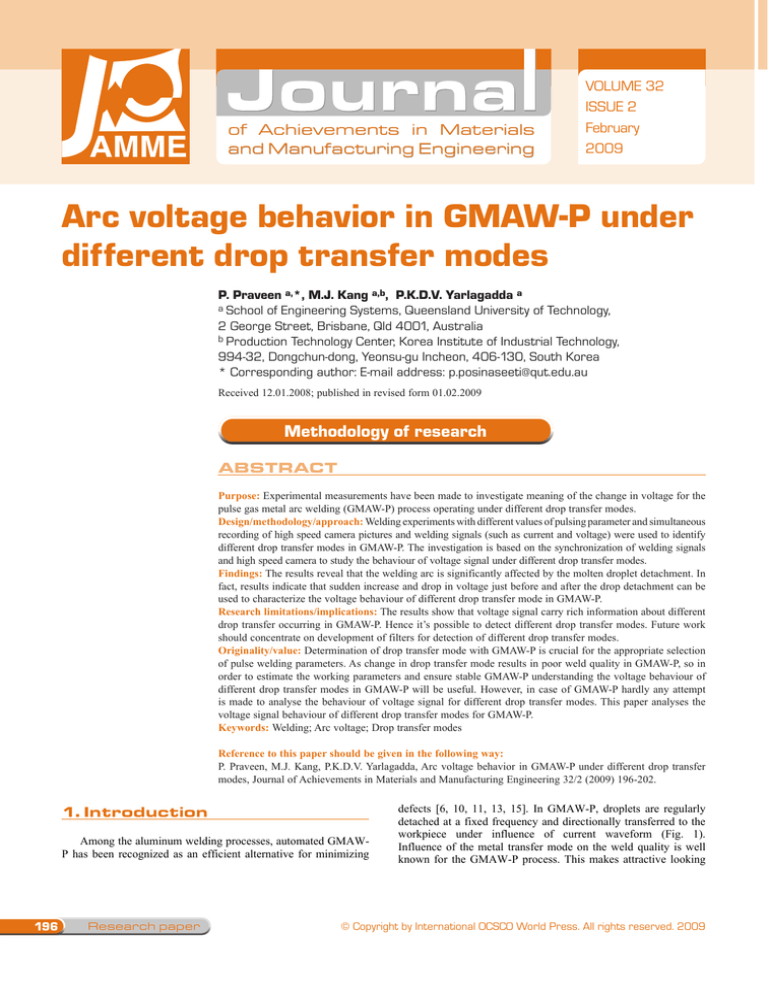
of Achievements in Materials
and Manufacturing Engineering
VOLUME 32
ISSUE 2
February
2009
Arc voltage behavior in GMAW-P under
different drop transfer modes
P. Praveen a,*, M.J. Kang a,b, P.K.D.V. Yarlagadda a
a School of Engineering Systems, Queensland University of Technology,
2 George Street, Brisbane, Qld 4001, Australia
b Production Technology Center, Korea Institute of Industrial Technology,
994-32, Dongchun-dong, Yeonsu-gu Incheon, 406-130, South Korea
* Corresponding author: E-mail address: p.posinaseeti@qut.edu.au
Received 12.01.2008; published in revised form 01.02.2009
Methodology of research
Abstract
Purpose: Experimental measurements have been made to investigate meaning of the change in voltage for the
pulse gas metal arc welding (GMAW-P) process operating under different drop transfer modes.
Design/methodology/approach: Welding experiments with different values of pulsing parameter and simultaneous
recording of high speed camera pictures and welding signals (such as current and voltage) were used to identify
different drop transfer modes in GMAW-P. The investigation is based on the synchronization of welding signals
and high speed camera to study the behaviour of voltage signal under different drop transfer modes.
Findings: The results reveal that the welding arc is significantly affected by the molten droplet detachment. In
fact, results indicate that sudden increase and drop in voltage just before and after the drop detachment can be
used to characterize the voltage behaviour of different drop transfer mode in GMAW-P.
Research limitations/implications: The results show that voltage signal carry rich information about different
drop transfer occurring in GMAW-P. Hence it’s possible to detect different drop transfer modes. Future work
should concentrate on development of filters for detection of different drop transfer modes.
Originality/value: Determination of drop transfer mode with GMAW-P is crucial for the appropriate selection
of pulse welding parameters. As change in drop transfer mode results in poor weld quality in GMAW-P, so in
order to estimate the working parameters and ensure stable GMAW-P understanding the voltage behaviour of
different drop transfer modes in GMAW-P will be useful. However, in case of GMAW-P hardly any attempt
is made to analyse the behaviour of voltage signal for different drop transfer modes. This paper analyses the
voltage signal behaviour of different drop transfer modes for GMAW-P.
Keywords: Welding; Arc voltage; Drop transfer modes
Reference to this paper should be given in the following way:
P. Praveen, M.J. Kang, P.K.D.V. Yarlagadda, Arc voltage behavior in GMAW-P under different drop transfer
modes, Journal of Achievements in Materials and Manufacturing Engineering 32/2 (2009) 196-202.
1.
Introduction
1. Introduction
Among the aluminum welding processes, automated GMAWP has been recognized as an efficient alternative for minimizing
196
Research paper
defects [6, 10, 11, 13, 15]. In GMAW-P, droplets are regularly
detached at a fixed frequency and directionally transferred to the
workpiece under influence of current waveform (Fig. 1).
Influence of the metal transfer mode on the weld quality is well
known for the GMAW-P process. This makes attractive looking
© Copyright by International OCSCO World Press. All rights reserved. 2009
Methodology of research
GMAW-P sensitive to operating parameters. Shape of the current
waveform dictates the type of metal transfer mode in GMAW-P.
The basic waveform parameters for GMAW-P current include the
background current Ib, peak current Ip, background time Tb, and
peak time Tp.
Several sensors have been developed to detect metal transfer
in GMAW. The most popular method to identify the metal
transfer and instant at which it occurs is through arc sensing
[24, 26,]. This system relies on detecting fluctuations in current
and voltage and correlating it with metal transfer mode. The
advantage of this method is the cheap cost [27]. High-speed
cinematography employing back-lighting shadowgraph is also a
common technique to observe dynamic metal transfer process
[24]. Other sensors based on acoustic emission, arc light etc. have
also been developed and investigated for its relationship with
metal transfer mode [3, 21]. The problem with these type is
corruption of signal due to background noise.
Fig. 1. Parameters of pulsed current waveform
Understanding influence of pulsing parameters dictating the
current waveform on the metal transfer modes has been one of the
major objects of several researches for a long time and a great
number of works has been carried out with an objective of
identifying and explaining the metal transfer mechanisms [25].
Most of the previous research in GMAW-P has used the
experimentation technique to characterise, establish region of
stable metal transfer and developed several static droplet
detachment metal transfer mode [1, 2, 4, 8, 9, 12, 15, 19, 22, 27].
These models employ certain simplifications which result in
discrepancies between the predicted and experimental results.
Hence there is still gap in our knowledge preventing us from fully
understanding the droplet dynamics especially for the newer
materials like Aluminum [29].
Identification of the prevalent metal transfer modes in real
time becomes important when the target is optimization and
control of the GMAW-P process. Generally for automated system
most robust and cheapest method for monitoring the metal
transfer phenomena is through arc sensing. But success of this
monitoring algorithm depends upon the knowledge of interaction
between the drop transfer and voltage signal and understanding of
the physical basis for the dynamics of droplet transfer.
This paper reports an experimental study to investigate the
metal transfer process in GMAW-P and the subsequent
assessment to understand the overall impact of droplet dynamics
on the current and voltage signals with a reasonable accuracy.
This was achieved by correlating precisely the welding arc
electrical signals (arc current and voltage) with the droplet images
recorded simultaneously in real time.
2.
Experiments
2. Experiments
2
Experimental
setup
2.1.1 Experimental
Setup
The experimental set-up used in this study is shown in
Figure 2. Through-the-arc sensing of the welding current, arc
voltage and high speed imaging of the droplet transfer are
assembled in conjunction with each other to study the influence of
the pulse current waveform on the metal transfer process during
GMAW-P. The experimental setup consisted of a pulsed type
inverter controlled GMAW power source with constant current
characteristics, automated welding system with 3-axis servo
motors and controllers, sensors for measuring actual welding
current and voltage signals, A/D converter, high speed camera
with 10000 frames/s performance and xenon lamp along with set
of lenses and filters was used as light source to provide back light
for high-speed filming.
Table 1.
Experimental design plan
Levels
1
Peak Current (A)
220
Base Current (A)
40
Peak Time (ms)
2
Base Time (ms)
10
2
250
50
4
16
3
280
60
6
22
4
310
70
8
28
Experiments were carried out using the principle of back-light
high speed xenon lamp cinematography which was synchronized
with data acquisition system. A high-speed video camera was
used to acquire the images of the droplets. The images acquired
by the high-speed video camera were transferred in the form of
video signal to the computer for analysis. The backlight was
projected by the xenon lamp after passing through a set of lenses
and filters towards the droplet/wire system. Light blocked by the
droplet/wire will not reach the lens. So in the process, almost all
of the arc light is eliminated and a shadow of the drop and wire is
captured by a high-speed camera. The advantage of xenon lamp
over laser light is lower cost and its larger light spot makes it
possible to capture the images of both droplet/wire system and
arc. Also diffused xenon lamp illumination needs to be focussed
over a small region by passing it directly through a mild steel
sheet cylinder. The arc voltage was measured between the contact
tip of the welding gun and the fixture. This allowed voltage
measurements as close to the arc as possible to most accurately
measure the arc voltage. The welding current was measured with
a Hall sensor, which was attached to the earth cable. A data
acquisition card in combination with a laptop personal computer
was used to acquire voltage and current signals alsong with high
READING DIRECT: www.journalamme.org
197
Journal of Achievements in Materials and Manufacturing Engineering
speed camera pictures. The sampling rate was 10 kHz. The noise
on the signals was removed by a digital low pass filter with a
200 Hz cut-off frequency.
Volume 32 Issue 2 February 2009
Based on Figure 3 it can be concluded that both current and
voltage signals have a repetitive fluctuating pulsing format and
appears to be noisy in general. They also appear to mimic different
metal transfer modes by varying in a very distinct manner for
different drop transfer modes. At first instance, it seems difficult to
understand the exact behaviour of the different characteristics
signals in conjunction with metal transfer modes observed. But
careful investigation by correlating the welding signals and high
speed camera reveal ample information that can be used to classify
different types of drop transfer modes occurring in GMAW-P
system based on the voltage and current signals.
Fig. 2. Schematic diagram of experimental setup
The data acquisition system measurements were compared to
a calibrated digital oscilloscope. Several measurements were
taken and synchronised with both the oscilloscope and the data
acquistion system, and subsequently compared. The waveform
signals were collected during a 2 s period after 10 s elapsed from
the start of welding.
a) Ip = 220A, Ib = 70A, Tp = 2ms, and Tb = 10ms
2.2.
Welding
conditions
2.2. Welding
Conditions
Bead on plate welds were made in the flat position using an
inverter controlled GMAW power source. Welds were made in
the constant current mode. The filler material used was a 4047
aluminum alloy welding wire with a 1.2 mm diameter. The base
material was 6061 aluminum alloy with a thickness of 6 mm. The
shielding gas used throughout the experiments was pure argon
with a gas flow rate of 20 L/min. Contact tip to workpiece
distance (CTWD) and speed was kept constant through out the
experiments. The values of CTWD and speed used for all the
experiments were 20 mm and 4 mm/s. Table 1 shows the setting
conditions of pulsing parameters used for the experimentation.
Figure 3 shows typical waveforms of welding current and voltage
for different metal transfer modes.
b) Ip = 220A, Ib = 40A, Tp = 6ms, and Tb = 10ms
3.Results
and
discussions
3. Results and
Discussions
The welding current and voltage as a function of time,
corresponding to three different drop transfer modes namely one
droplet per multiple pulses (ODMP), one drop per pulse (ODPP) and
spray or multiple drops per pulse (MDPP) respectively are compared
with each other in Figure 3. The measurements were made using
4047 aluminum alloy welding wire with 1.2 mm diameter at wire
feed rate of 4 m/min under different pulsing conditions.
198
Research paper
c) Ip = 220A, Ib = 40A, Tp = 8ms, and Tb = 22ms
Fig. 3. Typical welding current (top) and voltage (bottom) as
functions of time for different drop transfer modes, namely (a)
ODMP, (b) ODPP, and (c) MDPP
P. Praveen, M.J. Kang, P.K.D.V. Yarlagadda
Methodology of research
One drop per multiple pulses (ODMP) waveform is
characterized by two regions namely A, and B which occur
successively one after the other throughout the voltage waveform
and each region has frequency less than frequency of the pulse
waveform. These regions are shown in Figure 3(a). Region A is
characterized by almost constant voltage except for one instance
where sudden increase in voltage is observed where as Region B
is characterized by almost constant voltage except for two
instances where sudden increase in voltage is observed.
One drop per pulse (ODPP) waveform is characterized by one
region namely C, which occur periodically with every pulse and
has same frequency as the pulse waveform and droplet transfer
frequency. This is a key characteristic of the ODPP metal transfer
mode. This region is shown in Figure 3(b). The regularity of the
fluctuations suggests that the size and the process of each
individual droplet transferred in this mode are relatively steady.
Region C is characterized by almost constant voltage except for
two instances where sudden increase in voltage is observed.
Multiple drops per pulse (MPPP) waveform is characterized by
one region namely D (as shown in Figure 3(c)) which occur
periodically with every pulse and has same frequency as the pulse
waveform. This corresponds to a high frequency but smaller sized
multiple drops with a more or less constant arc length. Region D
is characterized by almost constant voltage except for multiple
instances where sudden increase in voltage is observed.
For all the drop transfer modes, arc length variation was
observed just before and after the droplet detachment. Also
current waveform appears to have very low frequency
components. The possible reason for this behavior is that the
inductance of the power supply has limited and smoothed the
change in the current as the welding power source is operating
in the constant current mode.
surface tension acting on the liquid metal is much higher
compared to electromagnetic force due to small current densities.
The droplet at the end of the electrode steadily grows during this
phase as seen in the high speed camera pictures of the region C
marked in Figure 4. As droplet reaches sufficient size, the current
is changed to higher peak value which corresponds to the start of
the region C. First sudden increase in voltage is observed in the
starting of region C (or starting of the peak phase of the pulse)
and corresponds to the power supply dynamics which occurs due
to need for faster response in the form of overshooting of actual
programmed values which are current and voltage [20].
3.1.
DropTransfer
transfer
characteristics
in
3.1. Drop
Characteristics
in ODPP
ODPP Online Signal
Online Signal
Lower peak time generally results in ODPP drop transfer
mode and as a result droplet detachment is generally observed at
the end of the peak time as seen in the Figure 3(b). Hence it is
difficult to explain the influence of droplet travel on welding arc.
So ODPP droplet detachment during the base current (see Figure
4) has been specifically selected to explain the influence of
droplet detachment and travel on the voltage signal in region C.
Figure 4 gives a generalised picture of ODPP phenomenon in
GMAW-P process using the synchronized images of the high
speed camera pictures with voltage and current waveform during
ODPP mode and region C. Based on the evidence of electrical
signals for unit period of fluctuation together with high speed
camera pictures as shown in Figure 4, one can conclude that one
droplet detach every pulse. Also as Region C repeats itself
through out the pulse structure suggests that the droplets are all
transferred in a very similar fashion which is ODPP. Figure 4 also
reveals rich information about the influence of droplet formation,
necking, detachment and travel on the welding arc.
During the starting phase of the base time or droplet growth,
only a small amount of the liquid metal melts and assumes
hemispherical shape at the tip of the electrode wire. As a result
Arc voltage behavior in GMAW-P under different drop transfer modes
Fig. 4. Synchronized images of high speed camera pictures with
arc current and voltage waveform for ODPP [17]
As seen clearly in the high speed camera pictures of region C
in Figure 4, this sudden increase in voltage does not result in any
detachment and from this point onwards necking of the droplet
begins because of higher current in the welding system.
It is well known that a current-carrying conductor establishes
a magnetic field around the conductor. Hence, by pulsing the
welding current, magnetic forces may be used to detach drops
from the electrode. In the liquid drop at the tip of the electrode
with moderate and high welding current, the longitudinal
component of electromagnetic force (commonly referred to as
Lorentz force) acts as a detaching force which removes liquid
metal away from the neck region of the droplet promoting droplet
detachment [7].
Second sudden increase in voltage occurs just before the
droplet detachment due to necking at the solid-liquid interface. It
is observed as a small rise in the arc voltage, probably due to the
increased electrical resistance of the droplet neck just before
separation [14] and sudden reduction in arc length due to
elongation of the droplet.
199
Journal of Achievements in Materials and Manufacturing Engineering
Volume 32 Issue 2 February 2009
Droplet detachment event can be seen on voltage curve by
sudden drop in voltage as shown in Figure 4. Droplet detachment
event is characterized by drop in voltage due to sudden increase in
arc length just after the droplet detachment and simple recovery
from the necking effect. However sometimes droplet dynamics at
the end of the electrode just after the droplet detachment may
cause the voltage drop during droplet detachment to exceed the
voltage rise due to necking in the opposite direction. The reason
for this behaviour is that sometime just after the droplet has
detached, small amount of liquid metal still remains at the tip of
the wire, and unbalanced surface tension force causes the
remaining liquid to recoil and oscillate on the wire tip causing
small additional voltage drop [23].
a)
Fig. 5. Current density distribution in the welding arc: (a) Start of
the melting process, and (b) Just after droplet detachment (or at
the start of the droplet travel) [28]
Droplet travel in the welding arc is characterized by almost
constant voltage. General distribution of the current density in the
welding arc is uniform, originates from the electrode tip following
a fan like distribution and converges in the form of a circle on the
base metal as shown in the Figure 5(a). Since the droplet size is
close to electrode diameter, as a result the size of the droplet is
expected to have some influence on the arc. Especially the
distortion is most serious when the droplet is near the electrode as
shown in the Figure 5(b). In presence of droplet in the welding
arc, the current flow pattern is first in to the droplet and then from
droplet in to the base metal in the form of fan distribution again as
shown in Figure 5(b). Based on the comparison of current
distributions in Figure 5(a) and (b) during droplet formation and
travel, one can conclude that though the arc plasma are very
different but the outer shapes of the arc plasma are identical [28].
Also there is always a minimum in the electric potential in
different cathode sport curves which corresponds to the lowest
energy consumption by the system as the optimum value [5].
Hence droplet travel in the welding arc is characterized by almost
constant voltage.
3.2.
DropTransfer
transfer
characteristics
in
3.2. Drop
Characteristics
in MDPP
MDPP
Online Signal
Online Signal
As discussed above, MDPP mode has certain characteristics
features in the region D, and this region has same frequency as the
pulse waveform. Synchronized images of high speed camera
pictures with voltage and current waveform during MDPP mode
and region D represented in Figure 3(c) is shown in Figure 6.
200
D
b)
Research paper
Fig. 6. Synchronized images of high speed camera pictures with
arc current and voltage waveform for MDPP
Carefully correlating the welding arc signals (arc current and
voltage) with high speed camera pictures reveal that multiple
droplets detach in region D which has same frequency as pulse
waveform. The regular occurrence of Region D through out the
pulse suggests that the droplets are all transferred in a very similar
fashion. The influence of droplet formation, necking, detachment
and travel on the welding arc are similar to ODPP which has been
explained earlier in section 3.1. Droplet detachment instances of
droplets have been marked in Figure 6 showing synchronized
droplet images together with arc voltage and current signal at
corresponding times. The images selected give a generalised
picture of the MDPP phenomenon in GMAW-P. Based on the
evidence of high speed camera in Figure 6, we can conclude that
multiple drop detaches during MDPP after passing of single pulse,
but have a regular fashion corresponding to number of droplet
detachments. In MDPP mode, frequency of detachments (which
are recorded as sudden increase in the voltage signal) always
exceed the frequency of the waveform pulses.
3.3.
Drop
transfer
characteristics
in
3.3. Drop
Transfer
Characteristics
in ODMP
ODMP Online Signal
Online Signal
As discussed above, ODMP mode has certain characteristics
features in the region A and B, and this region has less frequency
than that of the pulse waveform. Synchronized images of high
speed camera pictures with voltage and current waveform during
ODMP mode and regions A and B are represented in Figure 3(b)
is shown in Figure 7. Carefully correlating the welding arc signals
(arc current and voltage) with high speed camera pictures reveal
that one droplet detaches for every two pulses in region B which
P. Praveen, M.J. Kang, P.K.D.V. Yarlagadda
Methodology of research
has lesser frequency compared to frequency of pulse waveform.
The regular occurrence of Region B through out the pulse
suggests that the droplets are all transferred in a very similar
fashion. The influence of droplet formation, necking, detachment
and travel on the welding arc are very similar to ODPP which has
been explained earlier in section 3.1. Droplet detachment instance
have been marked in Figure 7 showing synchronized droplet
images together with arc voltage signal at corresponding times.
The images selected give a generalised picture of the ODMP
phenomenon in GMAW-P. Based on the evidence of high speed
camera in Figure 7, we can conclude that one droplet detach
during ODMP after passing of two pulses, but have a regular
fashion corresponding to number of droplet detachments. In
MDPP mode, frequency of detachments (which are recorded as
sudden increase in the voltage signal) will always be less than the
frequency of the waveform pulses.
A
B
Results suggest that different stages of metal transfer in
GMAW-P influence voltage signal in different ways. The welding
arc is regular and short term variations in the voltage signal
occurs regularly corresponding to the droplet detachment as a
result of sudden change in the arc length just before and after
droplet detachment. Frequency of the pulse waveform was found
to have a fixed relation with the number of droplet detachments or
number of instances of sudden rise in the voltage. Frequency of
the pulse waveform was found to be smaller, equal and exceed the
frequency of droplet detachment for ODMP, ODPP and MDPP.
Acknowledgements
Acknowledgements
The authors gratefully acknowledge financial support from
Faculty of Built Environment and Engineering of Queensland
University of Technology (Australia), Korean Institute of
Industrial Technology (South Korea), Australian Research
Council and Queensland Government’s Growing the Smart State
program for supporting the experiments. Authors also wish to
gratefully acknowledge the contributions of Dr. Sehun Rhee and
members of Intelligent Monitoring and Control laboratory of
Hanyang University, South Korea especially Mr. Hyungjin Park
for helping in the experimental work described here. The authors
are grateful to the high performance computing (especially Mr.
Mark Barry) group for helping with graphical data representation
presented in this paper.
References
References
[1]
[2]
[3]
Fig. 7. Synchronized images of high speed camera pictures with
arc current and voltage waveform for MDPP
4.Summary
conclusions
4. Summary andand
conclusions
In this work, online signals for different metal transfer modes
in GMAW-P have been reported. Attempt has been made to
correlate the drop dynamics and electrical characteristics for
understanding the behaviour of the welding electrical signals
during the several phases of the metal transfer. Based on the
investigation reported in this work, it can be concluded that
detectable differences were found in the welding voltage for
detecting droplet detachment and different metal transfer modes.
Arc voltage behavior in GMAW-P under different drop transfer modes
[4]
[5]
[6]
[7]
S.C. Absi Alfaro, G.C. Carvalho, S.A. de Melo Júnior, Stand
off's indirect estimation in GMAW, Journal of Materials
Processing Technology 157-158 (2004) 3-7.
K.Y. Bae, T.H. Lee, K.C. Ahn, An optical sensing system
for seam tracking and weld pool control in gas metal arc
welding of steel pipe, Journal of Materials Processing
Technology 120 (2002) 458-465.
P.S.S. Balsamo, L.O. Vilarinho, M. Viela, A. Scotti,
Development of an experimental technique for studying
metal transfer in welding: synchronized shadowgraphy,
International Journal for the Joining of Materials 12 (2000)
1-12.
D.S. Correia, C. Vasconcelos Gonçalves, S.S. Jr. Cunha,
V.A. Ferraresi, Comparison between genetic algorithms and
response surface methodology in GMAW welding
optimization, Journal of Materials Processing Technology
160 (2005) 70-76.
M. Goodarzi, Mathematical modelling of gas tungsten arc
welding (GTAW) and gas metal arc welding (GMAW)
processes, PhD Thesis University of Toronto, Canada, 2003.
K.C. Jang, D.G. Lee, J.M. Kuk, I.S. Kim Welding and
environmental test condition effect in weldability and
strength of Al alloy, Journal of Materials Processing
Technology 164-165 (2005) 1038-1045.
L.A. Jones, T.W. Eager, J.H. Lang Magnetic forces acting
on molten drops in gas metal arc welding, Journal of
Applied Physics D 31 (1998) 3-106.
201
Journal of Achievements in Materials and Manufacturing Engineering
[8]
[9]
[10]
[11]
[12]
[13]
[14]
[15]
[16]
[17]
[18]
202
S. Kim, A. Basu, A mathematical model of heat transfer and
fluid flow in the gas metal arc welding process, Journal of
Materials Processing Technology 77 (1998) 17-24.
Y.S. Kim, Metal transfer in gas metal arc welding, PhD
Thesis, MIT, USA, 1989.
J.M. Kuk, K.C. Jang, D.G. Lee, I.S. Kim, Effects of
temperature and shielding gas mixture on fatigue life of
5083 aluminum alloy, Journal of Materials Processing
Technology 155-156 (2004) 1408-1414.
C.L. Mendes da Silva, A. Scotti, The influence of double
pulse on porosity formation in aluminum GMAW, Journal
of Materials Processing Technology 171 (2006) 366-372.
P.J. Modenesi, R.C. de Avelar, The influence of small
variations of wire characteristics on gas metal arc welding
process stability, Journal of Materials Processing
Technology 86 (1998) 226-232.
N. Murugan, R.S. Parmar, Effects of MIG process
parameters on the geometry of the bead in the automatic
surfacing of stainless steel, Journal of Materials Processing
Technology 41 (1994) 381-398.
J.H. Nixon, J. Norrish, Determination of pulsed MIG process
parameters, Welding and Metal Fabrication 4 (1988) 4-7.
P. Praveen, P.K.D.V. Yarlagadda, Meeting challenges in
welding of aluminum alloys through pulse gas metal arc
welding, Journal of Materials Processing Technology 164165 (2005) 1106-1112.
P. Praveen, P.K.D.V. Yarlagadda, M.J. Kang, Advancements
in pulse gas metal arc welding, Journal of Materials
Processing Technology 164-165 (2005) 1113-1119.
P. Praveen, P.K.D.V. Yarlagadda, M.J. Kang, Arc voltage
behaviour of one drop per pulse mode in GMAW-P, Journal
of Achievements in Materials and Manufacturing in
Engineering 17 (2006) 389-392
L. Quintino, C.J. Allum, Pulsed GMAW: interactions
between process parameters – part 1, Welding and Metal
Fabrication 85 (1981) 1-9.
Research paper
Volume 32 Issue 2 February 2009
[19] Z. Smati, Automated pulsed MIG welding, Metal
Construction 18 (1985) 38-44.
[20] S. Subramaniam, Process modeling and analysis for pulsed
gas metal arc welding of an aluminum automotive
spaceframe, PhD Thesis, West Virginia University, USA,
1996.
[21] J. Tam, Methods of characterizing gas-metal arc welding
acoustics for process automation, Ph. D. Thesis, University
of Waterloo, Waterloo, Canada, 2005.
[22] S. Ueguri, K. Hara, H. Komura, Study of metal transfer in
pulsed GMA welding, Welding Journal 64 (1985) 242-250.
[23] F. Wang, W.K. Hou, S.J. Hu, E. Kannatey-Asibu,
W.W. Schultz, P.C. Wang, Modelling and analysis of metal
transfer in gas metal arc welding, Journal of Applied Physics
D 36 (2003) 1143-1152.
[24] G. Wang, P.G. Huang, Y.M. Zhang, Numerical analysis of
metal transfer in gas metal arc welding under modified
pulsed current conditions, Metallurgical and Materials
Transactions B 35 (2004) 857-866.
[25] Q.L. Wang, P.J. Li, Arc light sensing of droplet transfer and
its analysis in pulsed GMAW process, Welding Research
Supplement 11 (1997) 458-469.
[26] J.H. Waszink, L.H.J. Graat, Experiment investigation of the
force acting on a drop of weld metal, Welding Journal 2
(1983) 108-l16.
[27] J.H. Waszink, M.J. Piena, Experimental investigation of
drop detachment and drop velocity in GMAW, Welding
Journal 65 (1986) 289-298.
[28] F. Zhu, A comprehensive dynamic model of the gas metal
arc welding process, PhD Thesis University of MissouriRolla, USA, 2003.
[29] P. Zhu, S. Simpson, Voltage change in the GMAW process
due to the influence of a droplet travelling in the arc,
Science and Technology of Welding and Joining 10 (2005)
244-251.
P. Praveen, M.J. Kang, P.K.D.V. Yarlagadda


